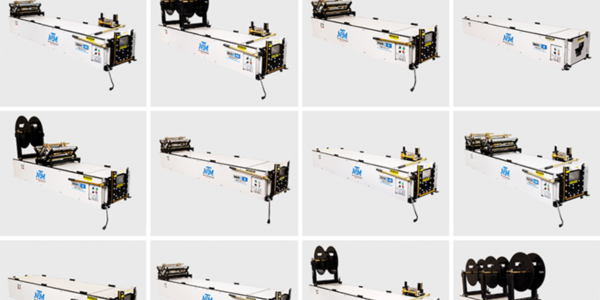IKO Hip and Ridge Cap Shingles from Style to Installation

With new laminated hip and ridge cap shingles, finishing a roof installation with a ridge cap is a much simpler process than with the old three-tab shingles.
In summary, to install the ridge cap shingles, you simply separate them where they are perforated, “bend” them over the peak, and nail them down. Of, course, there’s a little bit more to the process than that. You need to understand the function of ridge cap shingles, learn how to choose them, and understand how to make your installation look orderly and attractive.
Three Tab Shingles Compared to Laminated Shingles
The process to install ridge cap shingles has changed because roofing market trends have favored a new type of shingle. Three-tab shingles are easy to cut into strips to create a ridge cap, but now roofers and homeowners largely prefer laminated shingles.
Rob Davidson, Vice-President of Residential Sales for IKO Canada, explains why: “When I started with IKO over 20 years ago, three-tab shingles were the most common shingle installed. Since that time, laminated shingles have steadily grown in popularity and are now the dominant shingle style by far. Homeowners love their dimensional random appearance, and contractors like their ease of installation.”
Though they have many advantages, laminated shingles aren’t suitable as roof cap shingles because the two different layers of the shingles won’t bend in tandem. The solution? Roofing manufacturers introduced specific roof cap shingles made to work with laminated shingle installations that will look great and save you time.
IKO’s hip and ridge cap shingles are lightweight and perforated so that they can be quickly and cleanly divided by hand into three or four pieces. For quick installation, IKO Hip & Ridge PlusTMand IKO Hip & Ridge 12TM have factory-trimmed upper edges. This narrower, tapered cut allows for a clean installation, avoiding the possibility that upper parts of the shingle may be exposed along the sides of hips and ridges. This pre-trimmed capping saves you labor time, translating directly into lower costs. Also, homeowners will appreciate the neater finished look.
What Size are Ridge Cap Shingles?
IKO manufactures many types of ridge cap shingles, in a few different sizes, to meet local market preferences.
- In eastern Canada, IKO Hip & Ridge PlusTMis available, with a width equal to about 13 and one-eighths inches, and an exposure of five and five-eighths inches.
- In the eastern U.S., IKO Hip & Ridge 12TMhas been popular for many years and has just undergone a product enhancement. While each piece is still 12 inches wide, the exposure has been increased from five and one-eighths inches to five and five-eighths inches.
- In western regions, IKO Hip and RidgeTMshingles also have a five and five-eighths inch exposure, but four pieces are yielded from each strip of material, so each piece is only about nine and seven-eighths inches wide.
IKO also manufacturers different sized cap shingles to allow for “pot vents.” Many years ago, attic vents typically consisted of a combination of under-eave soffit vents and “pot vents” installed near the roof ridge cap. Some homeowners felt the pot vents detracted from the overall roof and home aesthetics. In response, the vent industry developed vents that were integrated right into a roof’s ridgeline, where they were less noticeable. Some of these ridge vents were disguised even further, by incorporating a ridge cap shingle layer on top of them. Different ridge vent styles and widths are available in different markets, and so ridge cap shingles are made to match the locally available vents.
A Bolder Look: Doubled and High-Profile Ridge Cap Shingles
You can accentuate the roof ridge cap and enhance the overall roof appearance with this simple ridge cap trick: double them up. In standard application, the ridge cap shingles are installed and lapped one at a time. But if you install them doubled up, with the top one about three quarter inches higher, it gives the appearance of a richer, thicker ridge cap or hip. The double look complements the double-layer thick structure of laminated shingles, thereby giving the whole roof a heftier, more robust appearance.
A double-layer cap installation provides a simple and relatively inexpensive aesthetic upgrade to any roof (standard single-layer cap installation shown inset for comparison).
Many years ago, this desirable, thicker roof ridge cap look inspired the introduction of a new type of ridge cap shingle: IKO UltraHP®. These high-profile ridge cap shingles are thicker and packaged prefolded. They are made with polymer-modified asphalt for added flexibility.
An impact-resistant option is also available. UltraHP®IR high profile ridge cap shingles are designed to be used with IKO Cambridge IR shingles for a complete impact-resistant roof. IKO UltraHP IR hip and ridge shingles have a Class 4 impact-resistance rating tested against UL 2218, which IKO is pleased to present for the sole purpose of enabling homeowners using these shingles in conjunction with Class 4 impact-resistance-rated shingles to obtain a discount on their home insurance premiums, if available in their area. This rating is not to be construed as any type of express or implied warranty or guarantee of the impact performance of this shingle by the manufacturer, supplier or installer.
Both types of ridge cap shingles, IKO UltraHP and IKO UltraHP IR, have an oversized eight-and-a-half-inch exposure for a more impressive, high profile look.
Choose a Ridge Cap Shingle Color
Usually, the hip and ridge shingles match the color blend used in the field of the roof although, in some markets, the hip and ridge shingles might be a contrasting color, which really frames the roof and accentuates the roof outline.
While IKO makes hip and ridge cap shingles to match their other shingle colors, there are more options. IKO Hip & Ridge 12 is now manufactured in innovative mid-tone color blends, to allow matching to a wider range of shingle styles and colors. Selecting the right color ridge cap shingle to match or contrast with your roof shingles can put the ideal finishing touch on a properly installed roof.
What Size Nails for Ridge Cap Shingles?
Ridge cap shingles are installed to overlap the field shingles. This means the nails that hold them onto the roof have to be a bit longer to ensure they fully penetrate the additional roof layers and can anchor themselves firmly into the roof deck. So, don’t forget those longer nail coils for your equipment. Use at least two-inch nails.
How to Install Ridge Cap Shingles
- Step One:Ensure the shingles aren’t too cold. Since ridge cap shingles have to be formed over the ridge, the shingles will be easier to handle if they are warmed a bit prior to cold-weather roofing. Since you only need a few bundles of capping per roof, many cold-weather contractors will simply pre-warm a few bundles in their truck cab prior to use.
- Step Two:Chalk lines should be used to help ensure clean, straight professional-looking shingle ridge cap installation. Determine the width of the shingle pieces and snap a line a little less than half that dimension on one side of the hip or ridge peak, then align the side of the shingles along that guide.
- Step Three:Installing ridge cap and hip shingles on the hips, you’ll start at the bottom, trimming the first piece so the corners of the hip shingles don’t extend into the gutter.
- Step Four:Nail the ridge cap shingle five and five-eighths inches above the butt edge, one inch in from each edge. You will have to nail higher if using over-sized ridge cap shingles, like IKO UltraHP.
- Step Five:When installing ridge cap shingles to the peak of a gable roof, you should begin at the end of the ridge opposite the prevailing wind direction, for optimum ridge cap wind resistance.
- Step Six:To finish a shingle ridge cap, you should set the final shingle in cement. Also cover the exposed nail heads in cement.
- Step Seven:If you need to replace a missing ridge cap shingle down the line, you will need a crowbar to gently pry up the shingles above the shingle you’re replacing.
When ridge cap shingles are installed properly, they accentuate the roofline; when done incorrectly, they detract from the roof. Below is an example of poorly installed capping. Note how the roofer neglected to trim the unexposed part of the shingle.
Combined with the apparent lack of chalk lines, this resulted in a messy-looking job. Using one of IKO’s pretrimmed ridge cap products could have greatly improved this installation.
For a full review of hip and ridge shingle installation, visit the IKO Blueprint for Roofing video series, Part 13. If you want to learn more about choosing hip and ridge cap shingles, visit IKO’s Design Center or use our Contractor Locator to find a contractor near you.
Learn more about IKO products at www.iko.com.
Editor’s note: this article first published on IKO’s blog and can be viewed here.























Comments
Leave a Reply
Have an account? Login to leave a comment!
Sign In